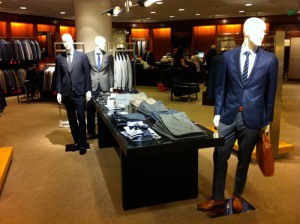 When you hear the name Nordstrom’s, what comes to mind?
When you hear the name Nordstrom’s, what comes to mind?
Shoes. Clothing. Quality. Yes, but chances are your first thought was great customer service, right?
Many of us have heard the Nordstrom’s legends of extreme customer experience. The first one I ever heard was about a man who went into the Nordstrom in Anchorage, Alaska, to return a tire.
Nordstrom’s doesn’t sell tires. The man had bought the tires from the tire store that had occupied the same space prior to Nordstrom’s moving in. But the Nordstrom store manager took the tires back. The story must be true, right? I read it on the Internet. It doesn’t matter if it’s true or not, it’s the type of legend that creates a brand perception. And it’s backed by a unique company culture that makes it seem it could be true.
But what about the manager? Does anyone know his name? After all, he’s the one who made the decision thanks to Nordstrom’s empowering rule for customer experience: “Use best judgment in all situations. There will be no additional rules.”
You see, when I think of Nordstrom’s, I think of Joel. Joel works at my Nordstrom’s. I love shopping Nordstrom’s because of Joel. (Although the next time my tires are looking a little worn, maybe I’ll give them a shot.)
I’ve stopped in Nordstrom’s from time to time, but if Joel isn’t working I mosey on out into the mall. I’ll just come back later…when Joel is working.
Because I’m a guy. With a few exceptions, guys don’t like to shop. There was a point in my life when store mannequins were my sole source of fashion sense. With their crisp pleats, a jacket tossed casually over one cocked shoulder and their stylish hats, tipped ever so jauntily to one side. I could never pull off that look, but I admired their static sense of adventure. So I bought my clothes from them. “Yep, I’ll take what he’s wearing. No, the whole thing. Even the socks.”
Now I have Joel. When Joel is there, I select a couple of items to try on and by the time I’ve returned from the dressing room, Joel has created my own mini-men’s department. He’s selected a few items that he knows I’ll love. Sometimes he’s wrong, but most of the time he is spot on. And there’s not a hint of “hard sell,” Joel’s just helping out. That’s what he does.
My experience, however, has been transformed. He has reduced my shopping time (which I hate) by half. He has made it effortless. It’s a shopping experience unlike any other. Do I buy all my clothes from Nordstrom’s? No. But I talk about Nordstrom’s. Actually I talk about Joel. And I’m not the only one. I’ve been out at an event, someone will compliment me on my jacket or shirt and I’ll mention Joel. Their eyes light up and they practically squeal: “I shop with Joel too! He’s the best!”
Great employees aren’t just part of your customer experience, they are the KEY to your customer experience. (Nordstrom’s, heed my advice. Joel is worth his weight in gold. You should set about developing the science to clone Joel.)
Joel has intuitively figured out what is meaningful to his customers. An effortless experience. Nordstrom’s is known for customer service, but because of people like Joel, they are really known for customer experience. (See our blog on the differences.)
“Delighting” customers doesn’t pay. Making their lives easier does.
According to their book, “The Effortless Experience: Conquering the New Battleground for Customer Loyalty,” authors Mathew Dixon, Nick Toman and Rick DeLisi outline their research demonstrating the value of simply making it easier for your customers to buy.
“Today’s customer puts a lot of value on how well a company delivers on its basic promises, solves day-to-day problems and helps them avoid future issues. Companies underestimate the benefit of simply meeting these customer expectations, because it goes against the conventional wisdom of ‘above and beyond,’” said co-author Matthew Dixon, executive director, CEB. “To build loyalty, companies need to actually think like the customer. This means stop thinking ‘exceed expectations,’ and start thinking ‘make it easy.’”
Where does it start? By understanding your employees. Just like we help our clients map the customer journey, we also help them map their employee journey, providing a roadmap that includes:
- Identifying the right personality for the culture.
- Providing employees a clear picture of the customer and their needs.
- Soliciting ideas and feedback from employees.
- Cultivating “intrapreneurial” talent by providing them with tools to own their experience and accountability.
- Recognizing their efforts. Not just the extreme customer experience success stories, but also the every day accomplishments.
Today’s customer demands more. If you want to put the customer first, YOU, as a leader, must to put your employees first. It’s not about having a ping-pong table or a corporate chef. It’s about having the right culture. Once the culture is in place, the customer experience becomes remarkable. I could find the same or similar clothing elsewhere. I could definitely find less expensive options elsewhere. But I can’t find Joel elsewhere. Because Joel prefers the Nordstrom’s culture.
People like Joel make you look good.
Helicx provides companies and organizations with a toolbox of processes (assessments, benchmarking and workshops) to enable them to create systems that attract and retain the best customers and the best employees. The Helicx process focuses on the business activities that most influence the customer experience such as marketing, sales, employee interactions and leadership. To see if these processes are right for your organization, take this survey.


